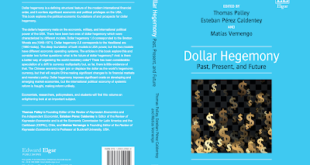[embedded content] Esteban Pérez's talk at the University of Chile, about Raúl Prebisch, about whom we have written several papers. This is in Spanish.
Read More »Dollar Hegemony and Argentina
[embedded content] First part of a two part interview with Anita Fuentes at Security in Context. The discussion on Argentina and Milei is in the next part. I'll post it as soon as it is up.
Read More »Dollar Hegemony, coming soon
The dollar's hegemony rests on the economic, military, and international political power of the USA. There have been two eras of dollar hegemony which were characterized by different models. Dollar hegemony 1.0 corresponded to the Bretton Woods era (1946-1971). Dollar hegemony 2.0 corresponds to the Neoliberal era (1980-today). The deep foundation of both models is USA power, but the two models have different economic operating systems. The articles in this book explore this and consider two...
Read More »The New IMF and the Covid Crisis
[embedded content]Video of the roundtable sponsored by the Review of Keynesian Economics on the changes (or lack of) at the IMF with Ilene Grabel, Marc Lavoie, Esteban Pérez Caldentey and Florencia Sember.
Read More »Esteban Pérez on John Maynard Keynes
One of my favorite economists, and John Maynard Keynes too. Don't miss this lecture, in Spanish of course, on one of the central economists of the 20th century and its relevance for the periphery, particularly during the current pandemic. I'll post links to the Zoom and Facebook stream soon.
Read More »Raúl Prebisch as a Central Banker and Money Doctor
Here we edited with Esteban Pérez and Miguel Torres some unpublished manuscripts from Prebisch related to the Federal Reserve missions, led by Robert Triffin, to the Dominican Republic and Paraguay, in which he emphasizes the need of capital controls in peripheral countries that did NOT have the key hegemonic currency. There is also a discussion of Keynes and White's plans for Bretton Woods, which were partially published before. In Spanish. Happy New Year!
Read More »New Book on Roy Harrod
Esteban Pérez Caldentey has just published a new book on Roy Harrod for the collection edited by Anthony Thirlwall. From the description: This landmark book describes and analyzes the original contributions Sir Roy Harrod made to fields including microeconomics, macroeconomics, international trade and finance, growth theory, trade cycle analysis and economic methodology. Harrod’s prolific writings reflect an astounding and unique intellectual capacity, and a wide range of interests. He...
Read More »Raúl Prebish’s Unpublished Manuscripts on the Buenos Aires Lectures on Economic Dynamics
By Esteban Pérez CaldenteyRaúl Prebish’s Unpublished Manuscripts on the Buenos Aires Lectures on Economic Dynamics edited by Esteban Pérez Caldentey (ECLAC) and Matías Vernengo (Bucknell University), have been published in the ECLAC Review, August 2018 Raúl Prebisch (1901–1986), the Second Executive Secretary of the Economic Commission for Latin America and the Caribbean (ECLAC) which he joined in 1949 is mostly known for his long-run analysis and diagnostic of the development problem of...
Read More »Heterodox Central Banking in the Periphery
Our paper with Esteban Pérez on Prebisch's missions as a Money Doctor during the Fed-led missions directed by Triffin to Paraguay and Dominican Republic has been publish in Research in the History of Economic Thought and Methodology. From the abstract: Traditionally, monetary policy in Latin America followed the recommendations of the missions of the monetary “doctors” who defended an independent central bank and a pro-cyclical monetary policy, adhering to the automatic adjustment of the...
Read More »Financialization in Latin America
New book edited by Martín Abeles, Esteban Pérez Caldentey and Sebastían Valdecantos. From the description: The chapters in the book analyze the logic and effects of financialization in developing economies, peripheral financialization so to speak, in particular in Latin America. The first chapters look at the topic from a historical and conceptual angles, and then the latter chapters concentrate on specific manifestations like the influence of financialization on productive investment,...
Read More » Heterodox
Heterodox






